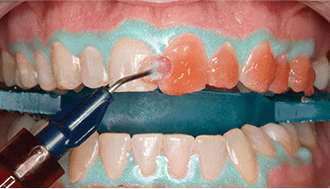Things you must know about whitening and tooth bleaching!
- Dr. Crissy Markova, VCO Orthodontics Arlington, VA

- Jul 10, 2023
- 3 min read
In-office bleaching: Most of our adult patients and some of our teen patients opt for some whitening at the end of orthodontic treatment. I've been testing different whitening methods over the years and developed a protocol for in-office whitening with excellent results. This is a 1.5 hour procedure in the office. I do a polish on the teeth first with a surface abrader to remove surface stains. Then, the gums around the teeth are blocked out with a gingival barrier to prevent the strong bleaching gel from getting on the gums. With this barrier, it allows me to block out areas of recession, sensitivity at the gums, or target specific teeth to prevent sensitivity. Multiple rounds of strong bleaching gel are placed on the teeth, while you listen to a Podcast or answer work emails. Once the bleaching process is completed, we give you 3 take home trays that you use for the next 3 days that take 15 mins each. I recommend that you do NOT eat or drink anything for 4-5 days that stains the teeth, such as coffee, dark tea, red wine, or curry. The teeth are transiently more porous with bleaching and we do not want to counteract the bleaching with any stains. If you need to drink coffee, you can do it through a straw and rinse out with water afterwards. Quick espresso shots!
Most patients will find the results last around 6 months. You can always do some touchup bleaching with custom bleaching trays after 6 months to maintain the color bright.

Custom bleaching trays with bleaching gel can also be used instead of the in-office bleaching. This process takes about 2 weeks and the bleaching is more gradual. If you have sensitive teeth, then the bleaching trays are more comfortable. I have many patients with sensitive teeth and they are able to do the custom bleaching tray protocol well. I've tested different professional grade bleach over the years and have found that my overnight protocol works well for the longest-lasting results.
Over the counter bleaching kits: There are different kinds of "at home" bleaching kits. I'm not a big fan of whitening pens since I haven't seen them to be very effective. The gel that you put on your teeth rubs off pretty instantly. Something like Whitestrips can be fine but the bleaching chemical is more abrasive and causes more sensitivity. Also, if you are using a whitestrip of any kind make sure to cover all of the upper teeth. The strips are usually short and cover up to the canine, whereas a lot of patients will show teeth further back on smiling. So you'll need to use 2 strips to cover the upper teeth. Zoom whitening or whitening activated by a blue light (for example, Snow). The blue UV light acts as a catalyst to activate the bleach. Light emits heat and I have found that many patients can have extreme sensitivity with blue light activated gel. While it looks cool, my personal opinion is to opt for other methods. What will bleach: Keep in mind, fillings, crowns, veneers, or implants will not bleach. If you have a filling on your front tooth, it usually looks fine and can blend in with the lighter color of the tooth since the light will reflect from the adjacent tooth structure. A crown or veneer will maintain their color as is. If you have white spots on your teeth, the white spots will absorb the bleach more and look even whiter, giving a more speckled look. These white spots can be naturally occurring enamel differences or hypocalcification spots. Teeth have different underlying shades (some are more brown, yellow, or grey). If your teeth have an underlying grey tint, these are the hardest to bleach whiter and I would recommend the in-office bleaching for a better result since the bleach is a higher concentration. Whitening toothpaste: Almost all toothpastes will have "whitening" on their marketing. I am not as familiar with the more "off brand" toothpastes but I've had patients tell me that the Crest 3D White Brilliance 2 step kit seems to work well to keep up the white color. I do not recommend using this kind of toothpaste (or any more aggressive bleaching toothpaste) as your regular toothpaste. Bleach is usually composed of hydrogen carbamide or hydrogen peroxide and if you excessively bleach your teeth, then the teeth can become more brittle and very sensitive to cold. This kind of toothpaste can be used at the 6 month mark after your initial bleaching session for a few weeks. I personally use Aquafresh Whitening as my daily toothpaste since I like how it foams up more than other toothpastes.



























Comments